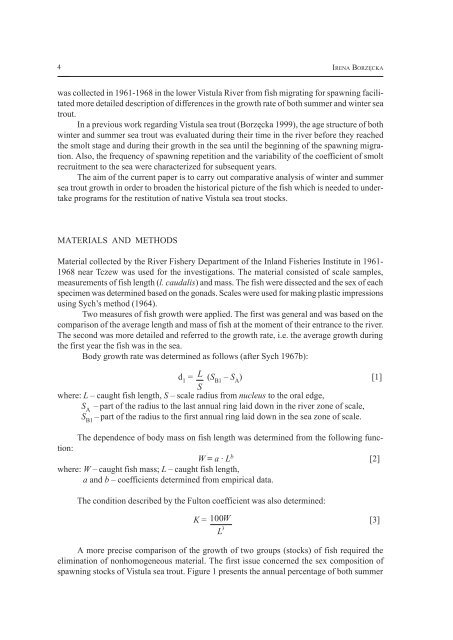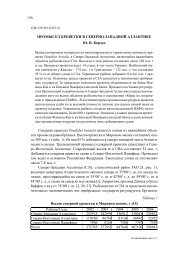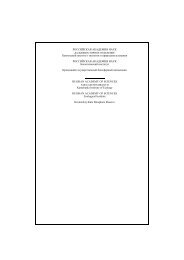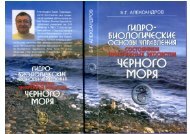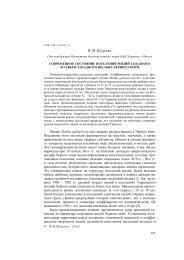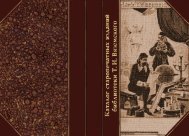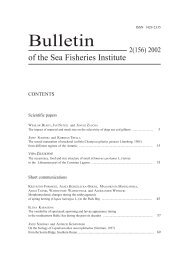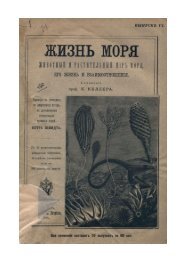Bulletin of the Sea Fisheries Institute 2 (153) 2001 - CEEMaR
Bulletin of the Sea Fisheries Institute 2 (153) 2001 - CEEMaR
Bulletin of the Sea Fisheries Institute 2 (153) 2001 - CEEMaR
You also want an ePaper? Increase the reach of your titles
YUMPU automatically turns print PDFs into web optimized ePapers that Google loves.
4<br />
IRENA BORZÊCKA<br />
was collected in 1961-1968 in <strong>the</strong> lower Vistula River from fish migrating for spawning facilitated<br />
more detailed description <strong>of</strong> differences in <strong>the</strong> growth rate <strong>of</strong> both summer and winter sea<br />
trout.<br />
In a previous work regarding Vistula sea trout (Borzêcka 1999), <strong>the</strong> age structure <strong>of</strong> both<br />
winter and summer sea trout was evaluated during <strong>the</strong>ir time in <strong>the</strong> river before <strong>the</strong>y reached<br />
<strong>the</strong> smolt stage and during <strong>the</strong>ir growth in <strong>the</strong> sea until <strong>the</strong> beginning <strong>of</strong> <strong>the</strong> spawning migration.<br />
Also, <strong>the</strong> frequency <strong>of</strong> spawning repetition and <strong>the</strong> variability <strong>of</strong> <strong>the</strong> coefficient <strong>of</strong> smolt<br />
recruitment to <strong>the</strong> sea were characterized for subsequent years.<br />
The aim <strong>of</strong> <strong>the</strong> current paper is to carry out comparative analysis <strong>of</strong> winter and summer<br />
sea trout growth in order to broaden <strong>the</strong> historical picture <strong>of</strong> <strong>the</strong> fish which is needed to undertake<br />
programs for <strong>the</strong> restitution <strong>of</strong> native Vistula sea trout stocks.<br />
MATERIALS AND METHODS<br />
Material collected by <strong>the</strong> River Fishery Department <strong>of</strong> <strong>the</strong> Inland <strong>Fisheries</strong> <strong>Institute</strong> in 1961-<br />
1968 near Tczew was used for <strong>the</strong> investigations. The material consisted <strong>of</strong> scale samples,<br />
measurements <strong>of</strong> fish length (l. caudalis) and mass. The fish were dissected and <strong>the</strong> sex <strong>of</strong> each<br />
specimen was determined based on <strong>the</strong> gonads. Scales were used for making plastic impressions<br />
using Sych’s method (1964).<br />
Two measures <strong>of</strong> fish growth were applied. The first was general and was based on <strong>the</strong><br />
comparison <strong>of</strong> <strong>the</strong> average length and mass <strong>of</strong> fish at <strong>the</strong> moment <strong>of</strong> <strong>the</strong>ir entrance to <strong>the</strong> river.<br />
The second was more detailed and referred to <strong>the</strong> growth rate, i.e. <strong>the</strong> average growth during<br />
<strong>the</strong> first year <strong>the</strong> fish was in <strong>the</strong> sea.<br />
Body growth rate was determined as follows (after Sych 1967b):<br />
d 1<br />
= L (S B1<br />
– S A<br />
) [1]<br />
S<br />
where: L – caught fish length, S – scale radius from nucleus to <strong>the</strong> oral edge,<br />
S A<br />
– part <strong>of</strong> <strong>the</strong> radius to <strong>the</strong> last annual ring laid down in <strong>the</strong> river zone <strong>of</strong> scale,<br />
S B1<br />
– part <strong>of</strong> <strong>the</strong> radius to <strong>the</strong> first annual ring laid down in <strong>the</strong> sea zone <strong>of</strong> scale.<br />
The dependence <strong>of</strong> body mass on fish length was determined from <strong>the</strong> following function:<br />
W = a · L b [2]<br />
where: W – caught fish mass; L – caught fish length,<br />
a and b – coefficients determined from empirical data.<br />
The condition described by <strong>the</strong> Fulton coefficient was also determined:<br />
K = 100W [3]<br />
3<br />
L<br />
A more precise comparison <strong>of</strong> <strong>the</strong> growth <strong>of</strong> two groups (stocks) <strong>of</strong> fish required <strong>the</strong><br />
elimination <strong>of</strong> nonhomogeneous material. The first issue concerned <strong>the</strong> sex composition <strong>of</strong><br />
spawning stocks <strong>of</strong> Vistula sea trout. Figure 1 presents <strong>the</strong> annual percentage <strong>of</strong> both summer


